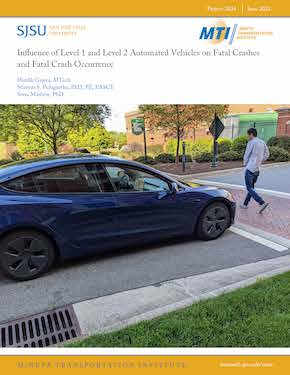- 408-924-7560
- mineta-institute@sjsu.edu
- Donate
Influence of Level 1 and Level 2 Automated Vehicles on Fatal Crashes and Fatal Crash Occurrence
Connected and automated vehicles (CAVs) are expected to improve safety by gradually reducing human decisions while driving. However, there are still questions on their effectiveness as we transition from almost 0% CAVs to 100% CAVs with different levels of vehicle autonomy. This research focuses on synthesizing literature and identifying risk factors influencing fatal crashes involving level 1 and level 2 CAVs in the United States. Fatal crashes involving level 0 vehicles—ones that are not connected and automated—were compared to minimize unobserved heterogeneity and randomness associated with the influencing risk factors. The research team used the fatal crash data for the years 2016 to 2019 for the analysis. A partial proportionality odds model is developed using crash, road, and vehicle characteristics as the independent variables and the fatal crash involving a vehicle with a specific level of automation as the dependent variable. The results of this research indicate that level 1 and level 2 CAVs are less likely to be involved in a fatal crash at four-way intersections, on two-way routes with wide medians, at nighttime, and in poor lighting conditions when compared to level 0 vehicles. However, they are more likely than level 0 vehicles to be involved in a fatal crash with pedestrians and bicyclists. Comparative analysis between vehicles with smart features and other vehicles indicated that pedestrian automatic emergency braking (PAEB) and lane-keeping assistance (LKA) improve the safety by reducing possible collision with a pedestrian and roadside departure, respectively. Contrarily, vehicles with other smart features are still highly likely to be involved in fatal crashes. This research adds to the growing body of literature that will identify potential areas for improvement in the safety of vehicular technologies and road geometry.
HARDIK GAJERA, MTECH
Hardik Gajera is a Ph.D. student in Civil & Environmental Engineering Department at the University of North Carolina at Charlotte, NC, USA. His current research interests include traffic operations and safety, traffic simulations, and connected and automated vehicles.
SRINIVAS S. PULUGURTHA, PHD, PE, FASCE
Dr. Srinivas S. Pulugurtha is currently working as a Professor & Research Director of the Department of Civil and Environmental Engineering at the University of North Carolina at Charlotte. He is also the Director of the Infrastructure, Design, Environment, and Sustainability (IDEAS) Center at the University of North Carolina at Charlotte.
SONU MATHEW, PHD
Sonu Mathew received his Ph.D. degree in Infrastructure and Environmental Systems from the University of North Carolina at Charlotte, NC, USA. He is a Postdoctoral Researcher with Infrastructure, Design, Environment, and Sustainability (IDEAS) Center at the University of North Carolina at Charlotte, NC, USA. His current research interests include traffic safety, traffic flow modeling and simulation, ITS, connected and automated vehicles, and spatial modeling.
-
Contact Us
San José State University One Washington Square, San Jose, CA 95192 Phone: 408-924-7560 Email: mineta-institute@sjsu.edu






